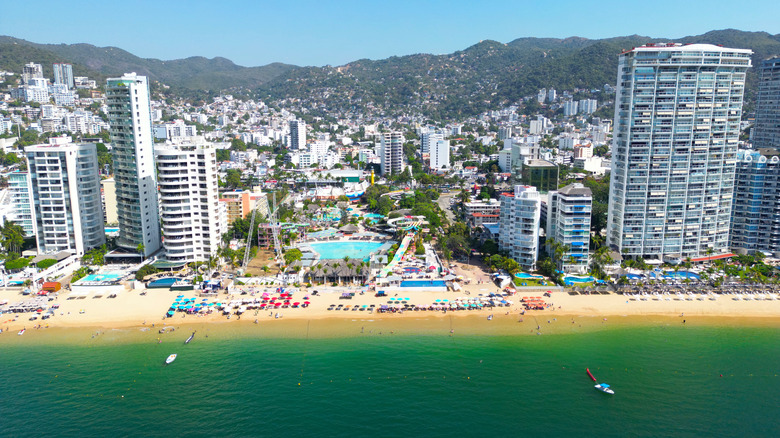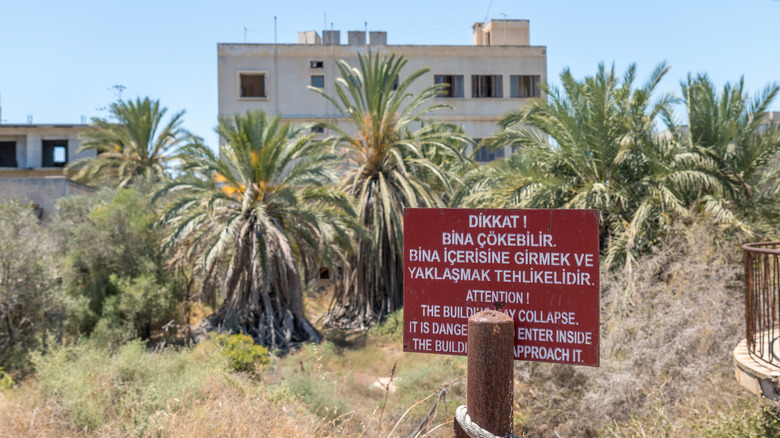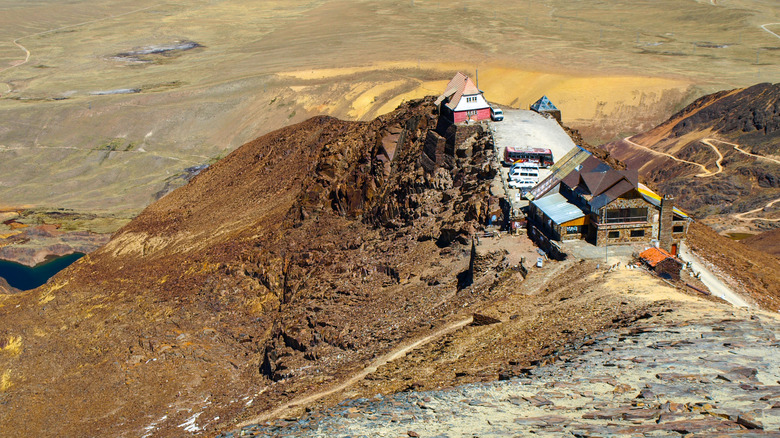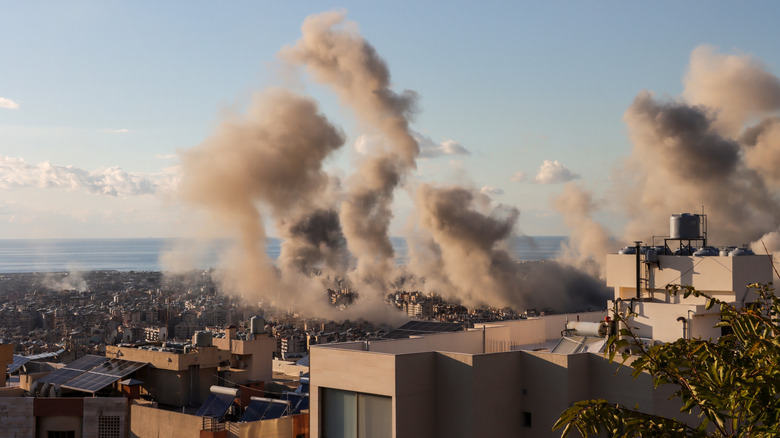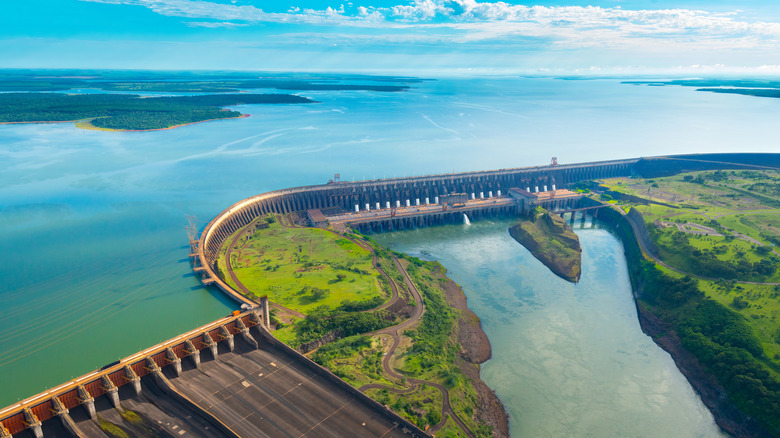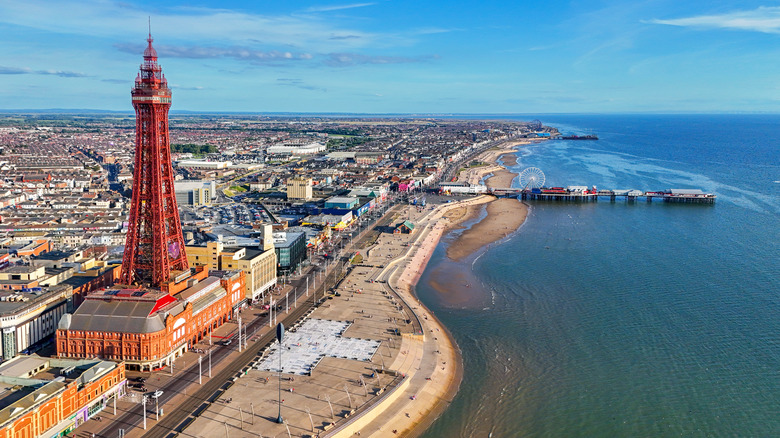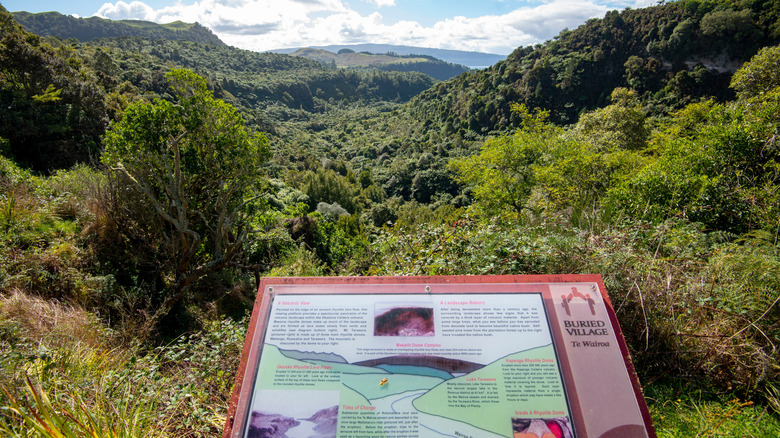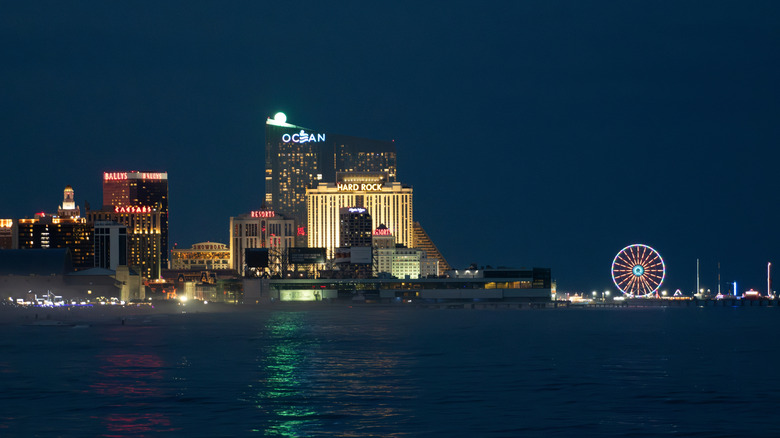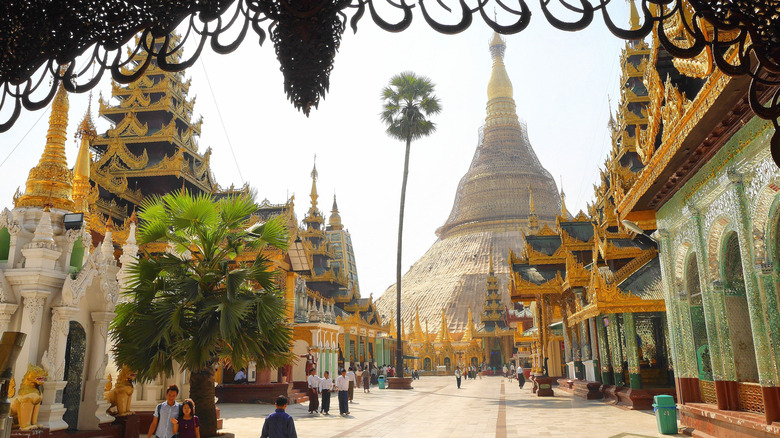10 Once-Glamorous Tourist Hotspots That Fell On Hard Times And Never Recovered
Unless you're one of the lucky ones who got to experience them, you've probably never thought about all those tourist hotspots that declined and never bounced back. Many of us plan trips to the next big thing — like trending tropical islands or luxury resorts that claim to have the world's best sunsets — without thinking that those places may well be next to decline. There are plenty of destinations worldwide that once soaked up all the money, attracting the elite and building entire economies on the promise of escape or indulgence. Unfortunately, some of them built too fast, while others refused to move with the times. Some were just extremely unlucky. As travelers, we should probably appreciate the places we go to a bit more, just in case they become tomorrow's faded glories.
A destination's golden era can end just as quickly as it began. War zones can replace party strips in the blink of an eye, and quiet emptiness can soon take the place of crowds. Even nature itself can wipe the slate clean in an instant. However, a few popular destinations that saw their fortunes fade are now planning to claw their way back, proving that these places don't disappear entirely. Well, that's not true; a couple on this list literally did. Others just accepted their fate. So, here are a few once-glamorous tourist hotspots that fell on hard times and never recovered. Well, for some of them, at least not yet.
Acapulco, Mexico
Acapulco is a seaside destination in Mexico that was once the definition of glamour. Its natural beauty and azure waters lured celebrities like Elizabeth Taylor and Frank Sinatra, as well as royalty and world leaders such as King Edward VIII and John F. Kennedy. The John Wayne-owned Los Flamingos and El Mirador (with its cliffside nightclub) served as glamorous social epicenters. The latter gave visitors prime views of the daring La Quebrada cliff divers, whose tradition of diving into the Pacific from 130 feet began way back in 1934.
The appeal of Acapulco, however, waned in the mid-1980s. At this time, Cancún began its surge as Mexico's premier spot. Aggressive marketing teamed with modern, all-inclusive resorts to eclipse Acapulco's aging infrastructure, but a surge in cartel violence proved to be much more devastating to the old favorite. Acapulco really went loco and turned into a battleground, with heroin production fueling extortion, kidnappings, and brutal turf wars. This relentless violence earned it the unwanted title of "Mexico's Murder Capital," and it consistently ranks in lists of the world's most dangerous cities even today.
Despite the decline, tourism in Acapulco hasn't completely collapsed. It has been described as a "warm, faded postcard," and, incredibly, those daring cliff divers are still putting on nightly shows, although it's highly unlikely they feature the original cast. The Hotel Mirador continues its tradition of dinners overlooking the spectacle, and small waves of travelers have begun returning despite the ongoing violence. Efforts to revive the city's fortunes include new hotels, improved security measures, and marketing campaigns that have been buoyed by a 20% drop in homicides, all of which offer Acapulco cautious hope for the future.
Varosha, Cyprus
With world-class hotels, immaculate gardens, luxury shops, and legendary nightlife, Varosha was once considered the crown jewel of Cyprus. At its peak, it drew in the European elite as well as celebrity couples like Richard Burton and (again) Elizabeth Taylor. Around 700,000 visitors flocked there annually, and the city pulsed with life. Sunbathers lounged on its golden beaches, funky music spilled out from the stylish bars, and neon signs lit up the night with color and energy. Couples would stroll the palm-lined boulevards hand-in-hand and then dance until dawn in the glittering seaside clubs.
However, the glitz and glamour ended abruptly in 1974 when Turkey invaded the island. Residents fled, carrying only what they could, and the entire district was fenced off by the Turkish military. This "Forbidden Zone" was left to decay. Buildings were quickly looted, streets became overgrown, and roofs eventually started to collapse. The area was kept sealed off from the world for decades, and its return was used as political leverage. In recent years, the largely unrecognized Turkish Republic of Northern Cyprus has begun reopening parts of Varosha to visitors despite international objections. Today, you can explore this ghost town with its cracked roads, decaying cafes, and crumbling hotels, either on foot or by bike along marked paths, and officials have laid out plans for new hotels and casinos with a rumored €10 billion investment.
Chacaltaya Glacier, Bolivia
Chacaltaya was once the world's highest ski resort and a popular playground among Bolivia's elite classes. Visitors used to make their way up the 17,785 feet (5,420 meters) of dirt road and hairpin turns to reach the world's highest restaurant. There, they would indulge in coca tea and quinoa soup to keep the cold at bay and admire the sweeping views of the Andes and the cities of La Paz and El Alto far below. Then, when it was time, they would scrape their skis over the powdery snow and zigzag their way downhill. It was altogether a splendid time for all who made it, but the resort's downfall was written in the ice.
The glacier that once blanketed its slopes began to vanish rapidly. As the snow dwindled, customer numbers nosedived. Equipment — including the ski lifts — started breaking, and only a hardcore few would walk up to the last stubborn patches of snow. The entire resort eventually fell into disrepair and closed in 2006. Today, abandoned buildings and rusted signs creaking in the wind are pretty much all that is left of Chacaltaya Ski Resort.
Handfuls of tourists still brave the altitude to visit, with the crumbling cafes and decaying ski winches offering too much of a photo op. There's even one last slope with a defiant patch of snow where die-hard skiers and young locals attempt to make runs. Is there any hope for this resort to return to its former glory? Artificial snow is seen as too costly, and while there has been talk of turning the lodge into a gym for high-altitude training, no redevelopment has been confirmed. Chacaltaya will likely remain a remnant of the past.
Beirut, Lebanon
In the 1960s, Beirut was alive with energy and promise. Five-star hotels stood shoulder to shoulder along the seafront, streets buzzed with cafes and chatter, and smoky clubs drew patrons to their crowded tables with music that played well into the night. Socialites from the Western world chased a reputation of elegance and escape, and celebrities like Brigitte Bardot and Marlon Brando were a common sight in a city that never seemed to sleep. That "Paris of the Middle East" moniker was well-deserved.
However, years of conflict took their toll, starting with a civil war (1975 to 1990) that claimed the lives of over 150,000 people. Buildings were shattered, and whole districts were permanently scarred by bullet holes. Power struggles drew in foreign armies, deepened sectarian divides, and turned Beirut into a front line for regional rivalries. Banks collapsed, the currency lost its value, and poverty spread to half the population. In more recent times, a port explosion in 2020 flattened neighborhoods and killed over 200 people, while Israeli airstrikes have hit the city's southern suburbs.
Some places still try to keep the old spirit alive. A few clubs and cafes open their doors to locals and expats when security allows. Officials talk about lifting travel bans and running campaigns to bring visitors back, but these are just cautious steps in a city that knows instability all too well. Tourist numbers hover well under their past glory. Still, there's hope that even small gains might help steady this once flourishing economy, where it thrived as a bridge between West and East.
Guaíra Falls, Brazil
The city of Guaíra sits on the Paraná River on the Brazilian side of the border with Paraguay. It was once one of the country's most visited places, famous for its massive waterfall system, Guaíra Falls. At least 18 powerful cascades were grouped into seven roaring clusters, and they carried at least twice the flow of Niagara Falls. Their thunder was said to be heard over 15 miles away, and the constant mist cast rainbows over walkways and bridges where visitors wandered among lush flora and dramatic rock formations. The raw power was simply unmatched, not even by Iguazú Falls, the world's current largest waterfall system, which dramatically plunges into the same river basin just 150 miles south.
Guaíra Falls were to meet their end when treaties in the '60s and '70s committed Brazil and Paraguay to building the Itaipu Dam. By 1978, engineers had begun diverting the river and blasted the rock face to prevent collapse, an act that signaled the point of no return. However, that's not the final tragedy in this tale. In 1982, dozens of sightseers looking to catch a last glimpse of the falls were killed when the bridge they were on collapsed. The heartbreaking story ended in a 14-day flood that silenced the roar forever. Thousands were forced to relocate, and protests and rituals marked the drowning of forests, wildlife, and indigenous lands. In the end, a natural wonder that had awed for an eternity was lost beneath a vast reservoir in the name of progress.
Blackpool, England
Blackpool was once labeled as a "wonder of the world," such was its reputation. However, Rick Steves described it as England's own Coney Island, and that is probably closer to the truth. It was one of the first places to have electric streetlights, and by the 1880s, its historic electric tram line carried tourists alongside its famous promenade. By 1894, the completion of the Eiffel-inspired Blackpool Tower gave the city the tallest structure in the U.K. and firmly established it as a tourist hotspot for British holidaymakers. On top of the iconic tower, Blackpool soon became known for other beloved attractions like the Pleasure Beach amusement park and classic Victorian piers with their tearooms, ice-cream parlors, and old-school English seaside fun.
At its peak in the 1930s, the city pulled in millions of annual visitors and was widely considered the U.K.'s holiday capital, but this all changed in the '60s. Cheap Mediterranean package holidays lured Brits abroad, and by the '70s and '80s, many guesthouses and hotels had closed or were converted into apartments or bedsits (single rooms in a shared house). Parts of the city fell into neglect, with shuttered shops and rundown neighborhoods. By the 2000s and 2010s, Blackpool had some of the country's highest rates of alcohol and drug abuse.
Cuts to local government funding and years of underinvestment between 2010 and 2017 didn't help. Even so, visitor numbers did hit 21.5 million in 2023. However, it's thought this figure is misleading, as many were day-trippers looking for a simple day out at the seaside. Regeneration plans worth £90 million ($122.8 million) and marketing strategies branding it as "The U.K.'s Capital of Family Fun" aim to improve its image and attract families again, but these remain ambitions rather than guarantees.
Pink and White Terraces, New Zealand
The Pink and White Terraces that once fringed Lake Rotomahana on New Zealand's North Island were widely considered the planet's largest silica sinter formations at the time. The terraces were formed by hot, mineral-rich springs that deposited silica on their way down the hillside, creating stepped pools that formed dramatic natural structures. On one side were the White Terraces; opposite them were the Pink. Their color was thought to have come from either trace elements of iron and manganese or a type of heat-loving bacteria that thrives in warm pools. Whatever the reason, they were quite the spectacle, and the New Zealand authorities marketed them as the "Eighth Wonder of the World."
However, tragedy struck in 1886 when volcanic activity at Mount Tarawera caused explosions of steam that blasted holes in the lake bed. Molten rock and debris soon blocked the outflow, and the water level rose, expanding the lake's size and drowning the terraces. The country's premier attraction was lost forever ... or so we thought. An interesting development occurred in 2011 when a team of geologists discovered remnants of the colored formations under the lake. Today, tourists can cruise the waters and use an augmented reality app to visualize the hidden terraces. Tours also typically include a hike through the Waimangu Volcanic Valley and a visit to the Buried Village of Te Wairoa, which was a victim of the same catastrophic eruption.
Atlantic City, New Jersey
Atlantic City was one of the first seaside resorts in the United States. It was purpose-built in the 1850s, and new rail lines swiftly delivered northeastern city dwellers from their urban confines to the golden sands of the Atlantic shore. By 1870, the city's famous boardwalk was in place. It was lined with arcades, piers, and neon-lit amusements that drew in millions at a time when the seaside itself felt exotic to most people. Crowds packed into shows, couples and families strolled above the crashing surf, and everyone chewed on saltwater taffy.
Atlantic City soon earned the title of "Queen of Resorts," and by 1978, the casinos arrived. Millions of vacationers got Vegas-style entertainment by the ocean, and a regional monopoly lasted for several decades. But all good things must come to an end, and when new casinos opened in neighboring states, things started to go south quickly for Atlantic City. As a result of excessive building and borrowing, big properties soon went bankrupt. Revel and the Trump Taj Mahal went under, while four casinos closed in an 18-month period between 2014 and 2015, costing 8,000 jobs. The deteriorating boardwalk tried but failed to hide the desperation and decay of the surrounding blocks while labor disputes and declining gaming revenue strained city budgets.
There is talk of a revival, although plans have been ongoing for quite some time. City plans are focusing on boutique casinos, family attractions, and live music venues. Projects like The Playground, an upscale shopping and entertainment complex, add exciting nightlife. However, the glory days remain out of reach for now, and Atlantic City appears to be banking on its legacy as the classic American seaside resort to stay relevant.
The Hippie Trail
This was an overland route that ran from Europe through Turkey, Iran, Afghanistan, Pakistan, India, and Nepal before ending in Bangkok, Thailand. The Hippie Trail originated during the heydays of the late 1960s, flourished throughout the '70s, and was a call to free-thinking Westerners looking for adventure, spiritual enlightenment, and cheap hashish. Along the route, travelers clustered in hubs like the Pudding Shop in Istanbul, Freak Street in Kathmandu, Chicken Street in Kabul, and Khao San Road in Bangkok. These spots buzzed with activity and were places where travelers swapped tales and tips and rested up before venturing onto the next leg of their journeys.
The appeal of the Hippie Trail was fairly simple: Ultra-low-cost travel. That's not to take anything away from the amazing sites the backpackers saw along the route and the stories and experiences they took home. But cheap buses, hostels, and illicit substances certainly went a long way to establishing a route where Western youth disillusioned with consumer culture set out to seek Eastern spirituality and countercultural freedom. Makeshift communities were established, while shared meals and lengthy discussions under foreign skies became a way of life.
However, the dream ended fast in 1979 when the Iranian Revolution and the Soviet invasion of Afghanistan closed borders and made the route either impossible or too dangerous. Anti-Western sentiment intensified, and many of those once-welcoming stops turned into high-risk zones. By the 1980s, cheap air travel led to backpackers skipping some sections entirely or just heading straight to South or Southeast Asia, where the legacy of the Hippie Trail lives on in routes like the Banana Pancake Trail.
Myanmar
After decades of military rule, Myanmar began limited political reforms in 1995 and released Nobel Peace Prize winner and human rights activist Aung San Suu Kyi, who had spent six years under house arrest. By 2015, her National League for Democracy was in government, fueling hopes of lasting change and a tourism boom. There was indeed a wave of curiosity among travelers, and visitor numbers soared past 4 million by 2019. Golden pagodas, royal palaces, incredible teakwood bridges, stilted villages, and stunning white-sand beaches wowed tourists, many of whom felt that they were among the first to be let in on a long-kept secret. But, like Cambodia after the downfall of Pol Pot and the Khmer Rouge, the warmth of the people (despite the turbulent history) was what astonished travelers most.
However, the renaissance was short-lived. The 2021 military coup ended Myanmar's fragile democratic era, and with it came mass arrests, violent crackdowns, and outright civil war in many regions. Conflict zones and human rights abuses made the country off-limits once again, and tourism collapsed to a fraction of what it was. Despite its undeniable natural beauty, visiting Myanmar remains dangerous, and a Level 4: Do Not Travel warning has been set by the U.S. Department of State.
There is hope that the magic that once drew travelers can return. The shimmering Shwedagon Paya is a lesser-known Asian destination that every traveler should see, while potential world wonders like Bagan and the remarkable spirit of the people — who we shouldn't forget have been stripped of a vital income source — are things that simply must be experienced. It will take time and stability, which is something that feels out of reach for now. Hopefully, the people of Myanmar can get their country back.

